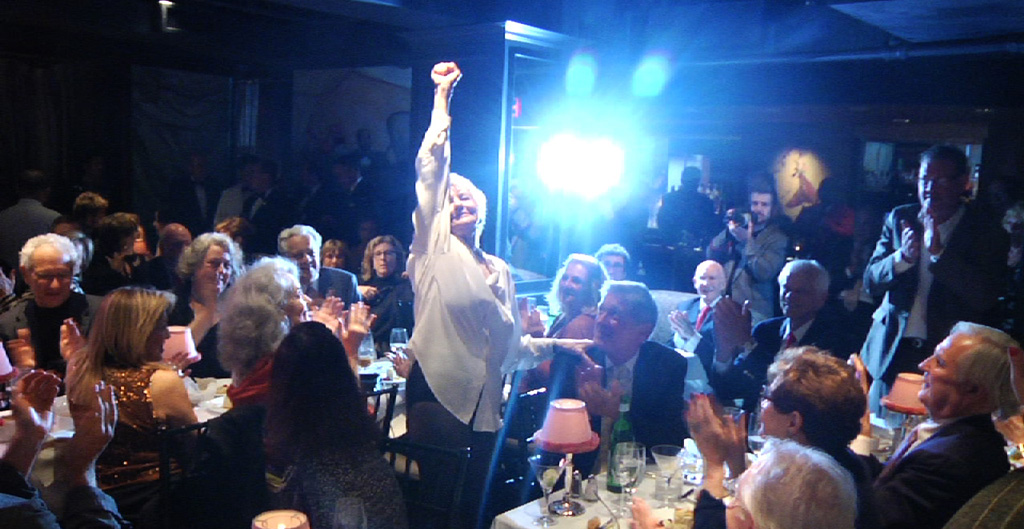A year removed from attending the raucous premiere of “Elaine Stritch: Shoot Me” at the Tribeca Film Festival, there’s something slightly bittersweet about seeing the film now. Not only did the legendary Broadway actress announce she’d be easing her way out of showbiz coinciding with the film’s unveiling, but in such a short span of time, the film’s time spent on the set of “30 Rock” and in the company of Stritch’s good pal James Gandolfini sadly have become associated with the past rather than the present.
However, in the spirit of the indomitable Stritch, that has only seemed to make Chiemi Karasawa’s portrait of an artist whose distinctively gravelly voice carries with it the gravitas from thriving for decades in one of the toughest industries imaginable all the more powerful and relevant as it’s finally seeing its release in theaters. Enormously entertaining, the film is as interested in the unvarnished truth as the unfiltered Stritch is, recounting a career in the theater in such landmark productions as “Company” while showing what life is like at 87 for the still-performing star as she deals with diabetes.
It’s considerably more than Karasawa bargained for her directorial debut when her hair stylist tipped her off to the grand dame in the next seat over and suggested she might make a great documentary subject. Yet the longtime producer of such films as Jennifer Venditti’s “Billy the Kid” and Ellen Kuras and Thavisouk Phrasavath’s “The Retrieval” handles it all with ease and elegance and shortly before the film makes its bow in Los Angeles, she spoke about her path to the director’s chair, how a small crew helped her capture such intimate moments with Stritch and her ever-evolving relationship with the consummate entertainer.

I went to film school as an undergrad at Boston University and I was majoring in film and broadcasting, and when I got out of college, I moved to New York immediately and started working as an assistant to a producer on a film called “Hangin’ with the Homeboys.” That eventually led me to pursue script supervising, just because it’s a position that’s next to the director for the entire filming process, and I figured that would be a great vantage point for me to learn because I think every kid comes out of film school wanting to direct, but not really knowing what the steps are into getting to be a professional director.
I thought that it was going to be a stepping stone for directing, but it turned into a 15-year career as a script supervisor alongside amazingly talented individuals like Martin Scorsese and Stephen Frears and Jim Jarmusch and Spike Jonze. Even though it was the scenic route to end up directing, it was also an incredibly influential route because I got to glean from some of the masters how they direct and their passion for directing.
This may not have applied, but since the role of script supervisor is to help keep track of a production, is there any application in nonfiction film like this in organizing a sprawling history such as Elaine Stritch’s?
Directing documentary and directing narrative are two totally different disciplines in a way because in the narrative process, you have the recipe for what you’re going to cook and it shows how you’re going to put all those elements together to make the final product. In documentary, you have to go and hunt and gather all the ingredients, then figure out what you’re going to make. It’s almost like you’re creating the recipe in the edit, whereas in narrative process, you’ve got the recipe.
The thing about script supervising that people don’t realize is that it’s your job to break down a script chronologically at the very beginning of the pre-production process, so you’re very hands-on in analyzing a screenplay and seeing how the story elements come together over and over and over again. How that was influential and instrumental to me in producing and directing documentaries is understanding how parts of a story come together to create a rewarding experience as an audience.
With someone with such a rich past as Elaine, was it always obvious to you to focus on the present day?
Yes, because one of the things that you learn about somebody like Elaine immediately upon meeting her is how in the present she is. She can talk about stars and experiences until the cows come home, but what I thought was magnificent about her was how she was living her life today at 87 because it’s one of the things that you don’t see portrayed in the media very often. This year, we had the benefit of seeing a film like “Nebraska” where you actually see an older person’s experience, but in terms of Elaine, she’s so vital and her life is so stimulating and exciting and she was still taking jobs and managing her career and walking 20 blocks to the hair salon and putting together a cabaret act.
When you have somebody like that, you don’t want to make the kind of film that you could make after they’ve passed on. You want to make a film about how they’re living their life right now because that story is going to be vital to all of us. What are the choices you make and what happens when obstacles and challenges come along that threaten the thing that you love to do the most and how are you going to deal with that? That to me was the universal aspect of her story. It’s somebody’s story that’s pretty extraordinary, but she’s facing everyday challenges that we’re all going to have to face at some point.

Intentionally or not, I think we all go through that trial-by-fire period with Elaine where she can be particularly thorny or caustic. She just needs to know, are you in for a penny or are you in for a pound? I don’t even know if she does it consciously or if it’s a subconscious thing of trying to feel out who this person is that wants to be around her, but in our case, it was more of a process of getting to know somebody. When a cameraman and a director is going to be around you all the time, you really want to get to know them. You want them to get to know you, so there was a certain amount of boundary setting in the beginning, like, “Why are you filming me from this side?” “Why are you making these choices?” Then when she became comfortable with who we are as people, then it was all access.
Probably three weeks into the process, we were hanging out at the diner with her and talking about what was going on in our lives and that’s when I think she really began to feel comfortable because we were beginning to be friends. That’s an ideal situation for any filmmaker, no matter how fly on the wall you want to pretend that the process is. Who wants to have anonymous people hanging around them all the time? You have to inure yourself to the fact that you are going to become part of this person’s life for a period of time and the more comfortable they are with you, the easier and more pleasurable it’s going to be for everybody.
Both in terms of shooting in tight physical spaces and to establish an intimacy, was it important to keep the crew to a minimum?
Yeah, that was instrumental in making this movie. I had one cameraman and there were three different guys that I had on speed dial in the event that I was going to go shoot something, just so I knew somebody would be available, but it was just myself and the cameraman and I would put a lavalier microphone on Elaine and we would shoot. We never used lights. We only had a boom operator once in the John Turturro scene because we knew we’d be in a big restaurant environment where we weren’t sure how we were going to be able to mic him or how close we were going to be able to be to them. Elaine is very distracted by a lot of people, so it was critical that we keep it just to a minimum of the people that she was comfortable with and the camera was quite small.
How long did you actually shoot for?
We shot on and off for a period of a year-and-a-half every week, every other week, whenever things were happening, and certainly during her show. Then we started editing and during the editorial process, which took about six months after the year-and-a-half we were filming, we did a couple of pickups here and there. It got to the point where she really liked having us around and when you’re 87 and living independently, it’s nice to have witnesses to what your experience is and just have people around with you that you like when you’re going through particularly challenging events or just to carry your bags home from the store or get you a cab to the doctor’s office. She recognized very quickly that we were useful. [laughs]
I certainly wouldn’t want you to speak for her, but did you get the sense that she wanted to do the film as a way of preserving her legacy? Since she announced her retirement coinciding with the film’s premiere at Tribeca, it seemed like she may have thought this through a little bit.
Like you say, I can’t speak for Elaine. I know that she wasn’t at that stage when we started filming her at all. She always approaches everything with this idea that it’s a never-ending process, that she’s going to continue to perform, and I think she still wants to have that door open, that if she could do it and she wanted to do it, then it’s out there for her. So I don’t know. I do know that several months after we started filming, she said to me, “You know, when you approached me that day in the hair salon, I thought, as I was leaving the salon that day and walking home, I thought this is something I should do. This is something I’d better do. I’m not sure why I felt that way, but it really hit me that it was something I should do.”

Yeah, it wasn’t done for the film. We knew that she had donated her archives to the Stella Adler Studio because it was something she was talking about very early on during our interviews on camera, but we didn’t know when the boxes from her storage would arrive and how she was going to select them. It happened the way it did in the movie. We got a call from her assistant, saying, “I think she’s going to come over this weekend…” and then I’d speak to Elaine and say, “Are you going to go look at the pictures this weekend,” and she’d say, “Yeah, maybe I will. I’ll let you know.”
We were on pins and needles because I knew that would be such a critical event to have in the film, to be able to peruse archival photos of the last 30 years with the subject involved. We knew that could provide a spine for the film in a way to glimpse her past, but it was just a treasure trove. Once that day arrived, we actually shot for two days.
A year removed from the premiere at Tribeca, has it been nice to reunite with Elaine to do some events in conjunction with the rollout of the film?
It’s a huge thrill because I had no idea where the film would go or how it would be received and thankfully, it’s been very well received. I think probably the person that’s the most thrilled and surprised is Elaine. It’s a huge gift for her to be able to see the people appreciate her as more than just a performer, but as a person because she’s never really put herself out there as warts and all. It’s always been about making them laugh, so the fact that’s she’s accepted in this way has been really fun to watch. It’s also somewhat poignant because we filmed this movie more than three years ago, so she’s a little bit further down the road, as they say, and she’s not quite as nimble anymore. She’s had some challenges with her health in the past couple of years, so in some ways, it was fortuitous that we caught her when we did and it’s all a very fortunate experience, but it comes with a lot of complexity attached to it.
It’s just so great you’ve got a movie to capture it all.
That’s the thing that I feel the most rewarded by is that I really set out to make the film to bring her to not only her fans, but to a generation that doesn’t know who she is, because I feel like everybody should know who she is. She’s such a remarkable character, a survivor of the performing arts business and just a one-of-a-kind role model of a woman.
“Elaine Stritch: Shoot Me” is now playing in New York at the IFC Center and the Lincoln Plaza Cinema and will open in Los Angeles at the Royal, the Pasadena Playhouse 7 and the Encino Town Center on March 7.




